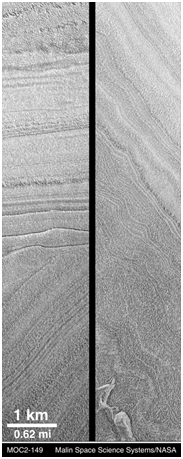

MGS MOC Release No. MOC2-149, 19 July 1999

The picture on the left shows an angular unconformity in a layered outcrop in the martian north polar cap. Unconformities are abrupt changes in the sequence of the layers--or beds--caused by an interval of erosion that was followed by resumed deposition of sediment. The amount of material removed is typically unknown, but the unconformity represents a break in the sequence of deposition--and therefore indicates a gap in the record that is otherwise preserved in the layered rock sequence. An angular unconformity indicates that before the upper, horizontal layers were deposited, there was a period in which the lower layers were tilted, as well as eroded.
The image on the right shows something different. Here, some of the north polar cap layers are shown as being folded or deformed. This can happen when some layers "flow" as they adjust to the added weight of new layers on top of them. Perhaps the fact that these layers contain a lot of ice--or so has been thought for the past 30 years--that allows them to become deformed in this manner.
Both pictures were among the first views of the north polar cap taken by the Mars Global Surveyor (MGS) Mars Orbiter Camera (MOC) narrow angle camera system in July 1998. Both are illuminated from the lower left. CLICK HERE for a mosaic of Viking orbiter images that shows the location and context of the two MOC images.
Malin Space Science Systems and the California Institute of Technology built the MOC using spare hardware from the Mars Observer mission. MSSS operates the camera from its facilities in San Diego, CA. The Jet Propulsion Laboratory's Mars Surveyor Operations Project operates the Mars Global Surveyor spacecraft with its industrial partner, Lockheed Martin Astronautics, from facilities in Pasadena, CA and Denver, CO.
Contact: info@msss.com